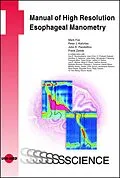There has been an explosion of interest in esophageal High Resolution Manometry (HRM). Today, less than 15 years after publication of the first paper describing this technology, there are now more than 1300 HRM systems in use worldwide. This manual is designed for use by physicians, surgeons and physiologists that use HRM for clinical measurement of esophageal function. Contents are divided into four sections including: - Practical instructions including step-by-step instructions for the acquisition and analysis of HRM - A primer on esophageal physiology and motility disorders - A practical guide to HRM technology and application in clinical practice - An atlas including step-by-step guide to the acquisition and analysis of HRM studies and more than 100 examples of clinical findings demonstrating the "range of normal and abnormal findings" observed during HRM studies The editors are grateful to all those members of the HRM Working Group that contributed to this manual to share their knowledge and experience gained from the first ten years of work with this exciting new technology.
Inhalt
1.Introduction161.1.Esophageal Structure and Function161.1.1.Anatomy161.1.1.1.Anatomical Structures161.1.1.2.Innervations171.1.1.3.Blood Supply181.1.2.Physiology181.1.2.1.Physiology of Swallowing181.1.2.2.Swallow Pattern Generator191.1.2.3.Deglutitive Inhibition191.1.2.4.Signals Involved in Swallowing191.1.2.5.Phases of Swallowing191.1.2.6.The Gastro-Esophageal Junction211.1.2.7.Transient Lower Esophageal Sphincter Relaxation (TLESR)211.2.Clinical Assessment of Esophageal Symptoms221.2.1.Heartburn and Regurgitation231.2.2.Dysphagia241.2.3.Chest Pain251.2.4.Rumination and Belching252.High Resolution Manometry282.1.Technical Aspects282.2.Conventional and High Resolution Manometry312.2.1.Concept and Development of HRM312.2.2.Gains over Conventional Manometry322.2.2.1.Anatomic and Technical Gains322.2.2.2.Assessment of LES Function332.2.2.3.Esophageal Body Contraction Segments352.2.2.4.Learner Preference352.3.High Resolution Impedance-Manometry372.3.1.Equipment372.3.2.Performing HRiM Testing382.3.3.Displaying, Analyzing and Interpreting HRiM Recordings382.3.4.Added Value of Impedance to HRM Recordings402.4.Study Procedure, Data Analysis and Normal Values432.4.1.Water Swallows432.4.1.1.Manometry Protocol432.4.1.2.Data Analysis462.4.1.3.Normal Values472.4.2.Multiple Liquid Swallows and Solids502.4.3.Pharyngeal Studies612.4.4.Pediatric Studies642.4.4.1.Manometric Assemblies642.4.4.2.Study Protocol642.4.4.3.Data Analysis and Normal Values652.5.Chicago Classification of Esophageal Motility Disorders682.5.1.Clinical HRM Study682.5.2.EPT-Specific Metrics682.5.3.Applying EPT Metrics to Score Individual Swallows712.5.4.Applying the Chicago Classification of Esophageal Motility723.Diagnosis and Management of Patients with Esophageal Disease783.1.Diagnosis of pharyngeal and UES dysphagia using HRM783.1.1.HRM to Identify the Pharyngeal and UES Anatomy783.1.2.HRM to Identify Pharyngeal and UES Physiology783.1.3.Objective Measurement of Swallow Physiology with HRM793.1.3.1.Pharyngeal Function793.1.3.2.Upper Esophageal Sphincter Compliance793.1.3.3.Pharyngeal Response to UES Function803.1.4.Deglutition Characterized Using HRM813.1.4.1.Pharyngeal Peristalsis823.1.4.2.Cricopharyngeal (UES) Dysfunction833.2.Achalasia883.2.1.Diagnosis883.2.2.Treatment883.2.2.1.Drugs893.2.2.2.Pneumatic Dilation893.2.2.3.Laparoscopic Heller Myotomy (LHM)903.2.2.4.Peroral Endoscopic Myotomy (POEM)903.2.2.5.Choice of Treatment903.2.3.Long Term Follow-Up913.3.Esophageal and EGJ Outflow Obstruction923.3.1.Pharyngeal Obstruction933.3.1.1.Presentation and Initial Investigation933.3.1.2.HRM Method and Diagnosis943.3.2.Esophageal and EGJ Obstruction943.3.2.1.Presentation and Initial Investigation943.3.2.2.HRM Method and Diagnosis963.3.2.3.Differential Diagnosis and Management963.3.2.4.Surgery963.4.Hypertensive Peristaltic Disorders983.4.1.HRM and EPT993.4.1.1.Integrated Relaxation Pressure (IRP)993.4.1.2.Distal Contractile Integral (DCI)993.4.1.3.Measurements of Propagation993.4.2.Diagnosis of Disorders of Increased Contractility993.4.2.1.Conventional Manometric Classification of Disorders of Increased Contractility1013.4.2.2.EPT Classification of Disorders of Increased Contractility1023.4.3.Disorders of Rapid Propagation1023.4.3.1.Conventional Manometric Classification of Disorders of Rapid Propagation1023.4.3.2.EPT Classification of Disorders of Rapid Propagation1033.5.Weak Peristalsis and Functional Dysphagia1063.5.1.Epidemiology1063.5.2.Pathogenesis1063.5.3.Diagnostic Work-up1063.5.4.Manometric Assessment of Peristaltic Integrity1073.5.4.1.Classification of Individual Swallows1073.5.4.2.Chicago Classification of Peristaltic Integrity Abnormalities1093.5.5.Management of Patients with Peristaltic Integrity Abnormalities1093.5.6.Functional Dysphagia1103.6.Gastro-Esophageal Reflux Disease (GERD)1113.6.1.Length of the LES and Resting Pressure1113.6.2.EGJ Morphology and Hiatal Hernia1113.6.3.Transient Lower Esophageal Sphincter Relaxations1123.6.4.Esophageal Dysmotility1133.6.5.Antireflux Surgery1144.Atlas1184.1.Acquisition1184.2.Analysis1244.3.EGJ Classification1314.4.Chicago Classification of Esophageal Motility Disorders1344.4.1.EGJ Dysfunction: Achalasia1344.4.2.EGJ Dysfunction: Outlet Obstruction1424.4.3.Peristaltic Disorders: Absent Peristalsis1474.4.4.Peristaltic Disorder: Distal Esophageal Spasm1484.4.5.Peristaltic Disorder: Hypercontractile Esophagus1514.4.6.Abnormal Motility: "Nutcracker" esophagus1534.4.7.Abnormal Motility: Hypotensive Dysmotility / Weak Peristalsis1534.4.8.Abnormal Motility: Rapid Contractions1564.5.Postprandial Observations: Reflux, Rumination, Belching1574.6.Pharyngeal Motility: Normal and Abnormal1645.Glossary168Index170
